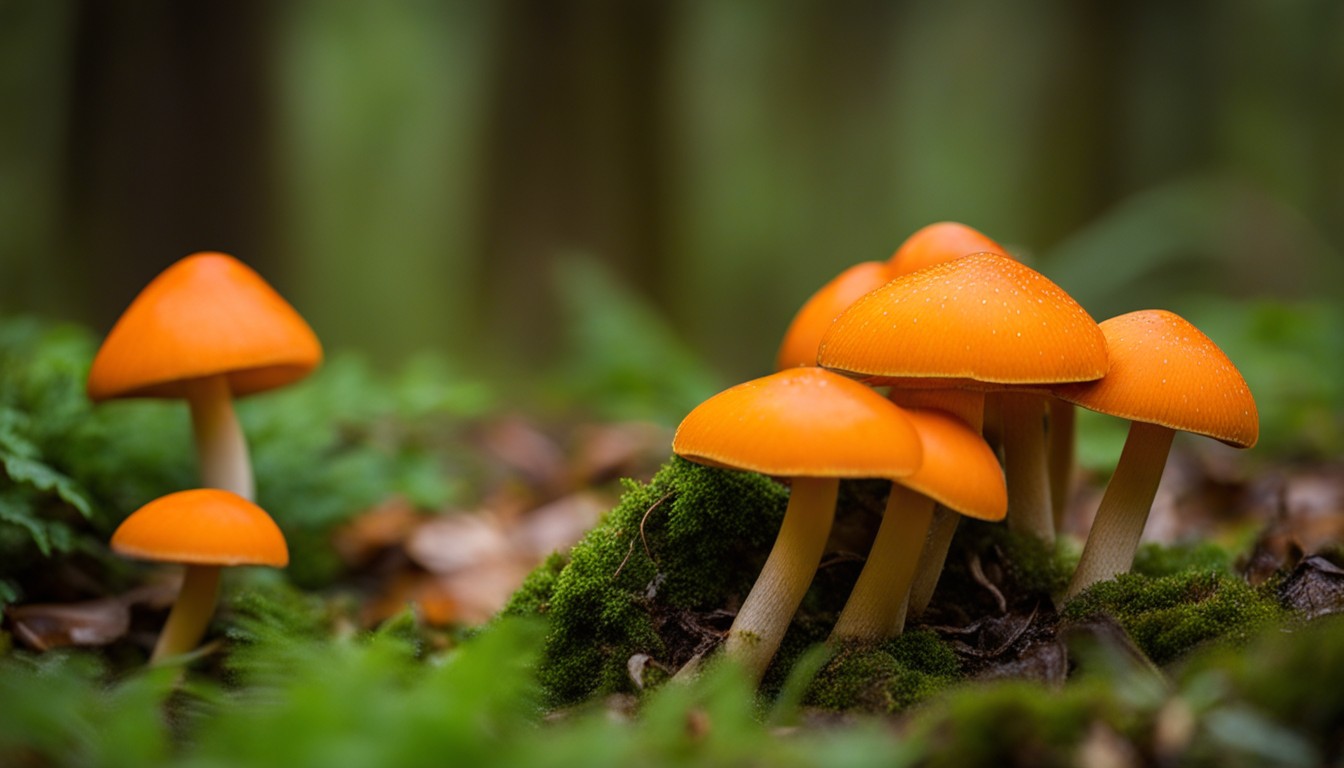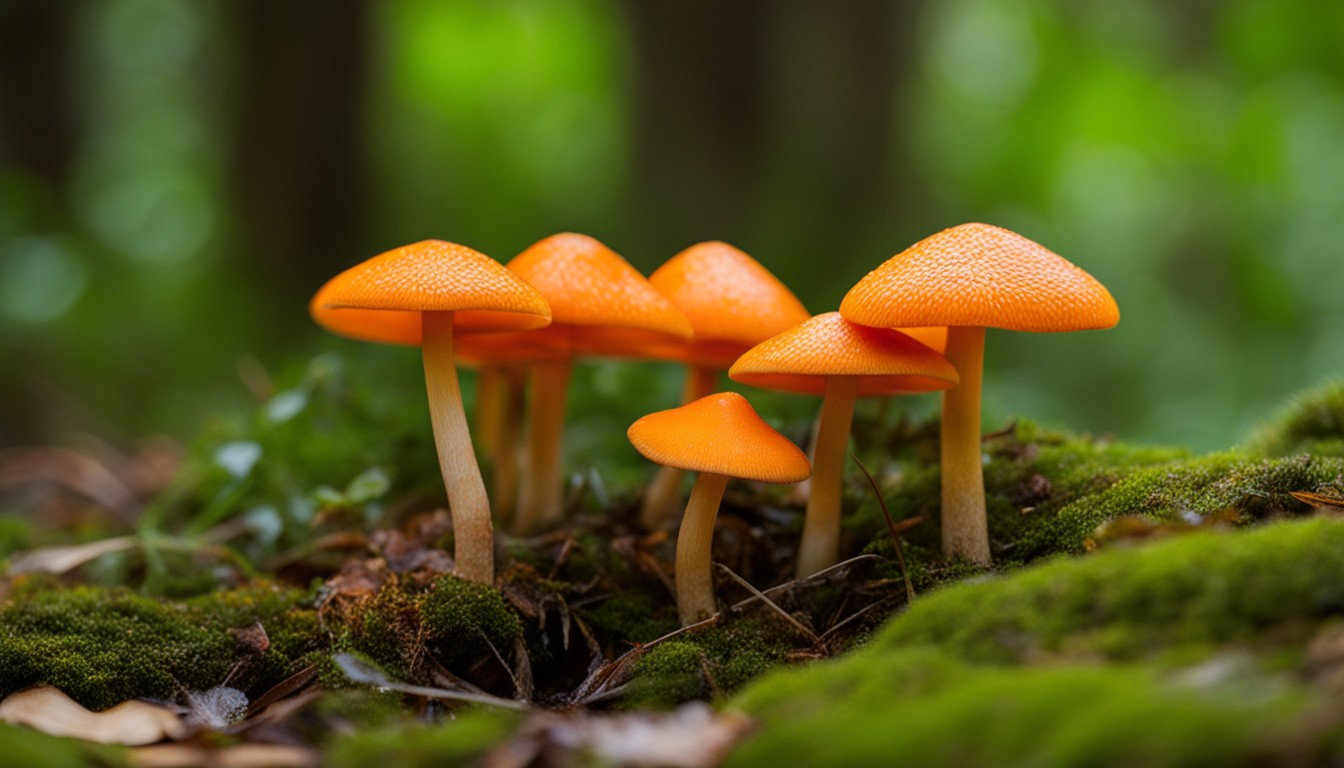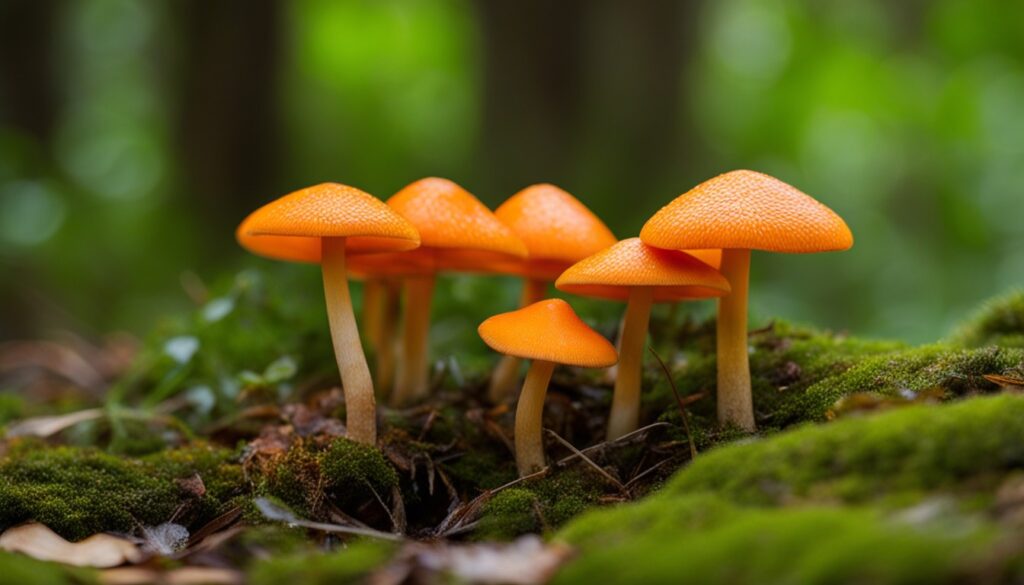Orange mushrooms can be found in various regions of Wisconsin, making it a fascinating destination for mushroom enthusiasts. In this comprehensive guide, we will delve into the world of orange mushrooms, focusing on their identification and the best ways to enjoy them. Whether you’re a seasoned forager or a curious nature lover, this article will provide you with valuable insights and practical tips for exploring the enchanting world of orange mushrooms in Wisconsin. So grab your hiking gear and get ready to embark on a mushroom-filled adventure in the Badger State!
Identifying Orange Mushrooms
Orange mushrooms, as the name implies, tend to have an orange coloration, spanning from soft peach tones to deep, vibrant hues. Depending on the variety, the shape can vary from flatter caps such as on chanterelles, to more bulbous structures found on others like the lobster mushroom. Size too, is variable with smaller variations at a couple of inches in diameter, scaling up to larger ones over a foot across.
Orange mushrooms differ greatly in shape, size and variety, mandating cautious identification as both poisonous and edible species exist.
Correct identification of orange mushrooms is critical, as both edible and poisonous species abound. Carefully examine their physical characteristics paired with knowledge about habitats and the time of year. For safety, reference a comprehensive guidebook or consult experts before consuming. Always err on the side of caution; if you’re unsure, don’t risk it.
Physical Characteristics
In the fascinating world of mycology, the physical characteristics of mushrooms are key factors in determining species – a crucial aspect when identifying Wisconsin’s orange mushrooms.
- Distinctive orange color varying from bright to rust-like hues.
- Caps may range from smooth to scaly, convex to flat or even funnel-shaped.
- Gills Run down the stem in some species, while others might not have gills at all.
- Stem structures differ greatly; some are thick and sturdy, others are thin and fragile.
- Presence of unique features such as veil, volva or pores.
Habitat and Growing Conditions
Orange mushrooms in Wisconsin flourish in diverse environments. Climate and weather significantly affect their growth patterns and habitability, making a comprehensive knowledge of their preferred conditions critical for successful identification and foraging.
- Optimum temperatures for growth usually range between 50°F to 60°F
- Humidity levels of 80 to 90 percent are ideal
- Orange mushrooms commonly grow in woodland locations and are often found near trees like oaks, pines, or willows
- They prefer slightly acidic to neutral soil pH
- Mushroom growth can be influenced by rainfall and moisture levels
- Most orange mushrooms favor decaying wood, leaf litter, or rich organic substrates
Common Types of Orange Mushrooms

The diverse terrain of Wisconsin, with its rich forests and humid climate, creates ideal conditions for various types of Orange Mushrooms to flourish. This diversity of topography and climate underpins the rich and varied mycoflora of the state.
In Wisconsin, you’re most likely to come across the aromatic Chanterelles, the unique Lobster Mushrooms, and the bright Chicken of the Woods. These are not just common, but also favored due to their distinct flavors and versatile culinary applications.
Chanterelles
Renowned for their golden hue and delicate composition, Chanterelles are a true seasonal treat in Wisconsin’s woods and forests. This mushroom family is famed for its unique apricot scent and a slightly peppery taste, with the potential to enhance various culinary dishes.
- Identifiable by their orange-gold color and funnel-shaped caps
- Chanterelles favor moist conditions and typically flourish in hardwood forests
- The apricot scent is a unique identifier for Chanterelles
- The mild, peppery taste makes them popular in gourmet dishes
- Chanterelles are generally safe to eat, but adequate identification is crucial
- Do not confuse Chanterelles with potentially toxic Jack-O-Lanterns; they look similar but Jack-O-Lanterns have gills, not ridges
- Always thoroughly clean and cook Chanterelles before consumption
Lobster Mushrooms
In Wisconsin’s forested areas, Lobster Mushrooms are easily recognizable. Their vibrant orange or red hue, reminiscent of cooked lobsters, coupled with a rough, textural exterior make them stand out among other fungi. Edible and cherished by culinary enthusiasts, they add a delicious dimension to many dishes with their strong, seafood-like flavor.
- Hard, robust exterior
- Bright red to deep orange colour
- Firm, white flesh
- Seafood-like aroma and taste
- Most commonly found in July and August
- Highly sought after for culinary uses
Chicken of the Woods
Chicken of the Woods is a distinctive variety of orange mushroom native to Wisconsin. Identifying it involves recognizing its vibrant, sulphur-yellow to orange color, its smooth, suede-like texture, and its growth on dead or dying trees, typically hardwoods. The flavor is often compared to lemony, chicken-like taste, which is why it’s frequently used in various culinary delights instead of chicken.
- Look for a bright orange or sulphur-yellow color. It often ranges from deep orange to pale yellow.
- Touch the surface of the mushroom. Chicken of the Woods has a suede-like texture.
- Take note of the tree on which it’s growing. They typically colonize dead or dying hardwood trees.
- After identification, cook it with lemon, garlic, or white wine to complement its natural taste.
Safety Precautions
Mushroom foraging requires meticulousness, particularly for orange mushrooms, where a misstep could lead to poisonous consumption. Always cross verify the identification with trusted guides and take note of each specimen’s unique characteristics.
Safety precautions extend beyond just identification when it comes to orange mushrooms. Prior to cooking them, ensure they are thoroughly washed to remove any dirt or grit. If trying a new variety for the first time, consume in small quantities to rule out potential allergic reactions.
Know Your Mushrooms
Wisconsin is home to diverse species of orange mushrooms, each distinctive in shape, size, and flavor. For beginners, categorizing them could seem daunting, but an understanding of their morphology aids accurate identification.
Mushroom identification is an acquired skill, which begins with familiarizing oneself with common features. The orange mushrooms in Wisconsin vary in cap shape, gill formation, spore color, and stem characteristics, thus demanding a discerning eye.
Mastering identification extends beyond physical characteristics. You must also factor in the habitat, growing conditions, and season. Thus, understanding these variables will greatly enrich your mushroom foraging experience in Wisconsin.
Consult Experts

The expertise of local mycologists can be invaluable for those keen on mushroom foraging. Not only do these specialists understand the fungus species populating Wisconsin’s varied ecosystems, but they also can assist with accurate identification, preventing wrong and potentially harmful guesses.
Wisconsin’s mushroom identification groups offer a wealth of information and a platform for discussion. These communities, both online and offline, are populated by avid foragers and mycologists sharing their experiences, knowledge, as well as providing support and answers to queries.
Such resources not only help beginners, but also experienced foragers in finding hidden fungal treats, or confirming the safety of a questionable find. Engaging with local experts and communities enables you to avoid rookie mistakes and ensures a safer and more rewarding foraging experience.
In addition to online forums and local workshops, many Wisconsin counties have mycological societies or clubs. These can be wonderful platforms for learning more about local fungi, from their scientific classification to their culinary use, enriching the overall foraging journey.
Foraging Orange Mushrooms
In Wisconsin, foraging for orange mushrooms is best during the temperate days of late summer and early fall; these are the months when they thrive and are most abundant. Pay keen attention to damp, sheltered woodland areas with ample shade, as these are favored by these vivid fungi.
Seek out orange mushrooms in locations where mature hardwood trees abound, particularly oak, birch, and beech. A careful look around the base of these trees could yield a rewarding bounty of these eye-catching, distinctive fungi, further enhanced by Wisconsin’s plush partisan geography.
Best Time to Forage
In Wisconsin, optimal foraging periods for Orange Mushrooms vary seasonally, with peak growth during late summer to early fall. These months provide prime conditions for mushroom development due to the balance of warm temperatures and frequent rainfall.
Specifically, the proliferation of Orange Mushrooms in Wisconsin peaks around mid-to-late August, tapering into September. This yearly cycle is a predictable pattern observed by experienced foragers and mycologists alike.
Factors such as soil moisture levels, temperature, and day length create the perfect environment for the mushrooms. Hence, deftly decoding nature’s calendar can aid in predicting peak mushroom growth for a more fruitful foraging experience.
Tools and Supplies
Venturing into the field of orange mushroom foraging necessitates certain essential gear. The forager’s toolkit typically includes guidebooks, magnifying glasses for detailed analysis, gloves for careful handling, and baskets or mesh bags for collection, to allow spores to scatter and proliferate.
A mushroom knife is a critical tool, designed with a curved blade for easy cutting and a brush on the opposite end to remove dirt. It protects mushrooms from damage and ensures clean, effective gathering.
A smartphone with access to online identification resources adds a technological advantage. Up-to-date, accurate digital guides often have images and information that can facilitate one’s mushroom hunt.
Taking precautions, such as wearing waterproof boots and long clothing, prevents injuries and stings. Pairing these with a reliable compass and a first aid kit, gears the forager for success even in unexpected circumstances.
Identifying Features to Look For
Deciphering fungal features, such as their gills, cap shape, and texture is an essential task in recognising orange mushrooms in Wisconsin’s diverse habitats. For instance, Chanterelles, a common variety, possess undulating cap edges and inrolled margins not present in all species.
It is important to look beyond the vibrant orange hue that earns these mushrooms their name. Size, spore color, and aroma are other distinguishing features. Some types of orange mushrooms, like the Chicken of the Woods, emit a pleasant citrusy scent.
Examining the stem, or stipe, detail, height, and thickness reveal more information about the mushroom’s identity. For example, Lobster Mushrooms boast a sturdy, reddish-orange exterior phase making it unique and distinctive from others.
Lastly, the minute details of the mushroom’s habitat can provide the final pieces to the identification puzzle. Take note of the types of trees nearby, season, or specific ground foliage, as many fungi have specific preferences and grow in conjunction with certain plants or trees.
Preparing Orange Mushrooms

The transformation from forest to table elevates the culinary art of preparing Wisconsin’s orange mushrooms. Their earthy, robust flavors shine when cleaned carefully, avoiding water saturation, and sautéed in a dash of butter or oil.
Unlocking the vibrant flavors of Wisconsin’s orange mushrooms lies within a trove of unique recipes. These range from traditional mushroom soup and risotto dishes, to experimental combinations with locally sourced game or dairy products, underlining the versatility of these fungi.
Cleaning and Washing
The first step in effectively cleaning orange mushrooms involves removing any apparent debris and dirt using a soft brush. Then, using a lightly damp cloth, wipe the surface. It’s pertinent to not fully submerge them in water as they quickly absorb it, compromising the texture and taste.
Thoroughly washing and cleaning orange mushrooms ensures their safe consumption. Begin by running the mushrooms under a mild, cold stream of water, focusing on the undersides where most dirt hides. Swift yet careful hands work best here, ensuring all sides receive adequate attention.
Patting dry the mushrooms immediately after washing can prevent them from becoming too water-logged. Quality paper towels or a clean kitchen cloth should suffice. Make sure you complete this before cooking, as moist mushrooms may produce an undesired texture upon being cooked.
Last but not least is the trimming of the stems. Some mushroom stems can be slightly tough or gritty, especially in wild specimens. A quick trim should resolve that and leave you with prime mushroom pieces ready for cooking.
Cooking Tips and Recipes
Whipping up a delight with orange mushrooms is an art. Master chefs often recommend sautéing them lightly in olive oil or butter, with a dash of garlic and fresh herbs to accentuate their earthy flavor.
Incorporating orange mushrooms in your everyday recipes can transform mundane meals into new taste adventures. They’re perfect additions to pasta dishes, stir-fries, or as a flavorful topping on pizza. Remember to always cook them thoroughly to bring out their unique taste.
Enjoying Orange Mushrooms
Orange mushrooms aptly serve any food adventures, satisfying palates with their divine taste, texture, and earthy undertones. Whether it’s a gourmet recipe or a simple sauté, they can be effectively incorporated into various diet regimens, providing a unique culinary experience.
Serving Suggestions
Unleash the gourmet in you with innovatively prepared orange mushrooms. Introduce them to salads, stir-fried veggies, or atop grilled meats for an enticingly earthy, fruity taste and vibrant visual appeal.
Transform your foraged orange mushrooms into a show-stopping meal. Enhance a creamy risotto, stir into an autumnal soup, or fold into an omelet for a scrumptious, hearty meal. Remember, with these wild wonders, less is more with seasonings.
Pairing with Wine or Beer
To create a unique dining experience, wine pairings with orange mushrooms can speak volumes. Sauvignon Blanc, known for its high acidity and citrus notes, pairs excellently with the earthy flavor of chanterelles.
A full-bodied Chardonnay, with its buttery undertones, may pair well with the Lobster mushroom’s seafood-like characteristics. Consider showcasing them in a creamy risotto to heighten the gastronomic experience.
Moving onto beer pairings, a Belgian saison seems perfect with its spicy and fruity notes harmonizing with the Chanterelle’s peppery undertones. The complex flavors provide an adventurous ‘Mushroom and Brew’ experience.
For a more robust selection, a brown ale’s malty sweetness nicely complements the Chicken of the Woods’ meaty flavor. This pairing underlines the mushroom’s hearty texture, creating a pairing that is nothing short of dynamic.
Frequently Asked Questions (FAQ) – Orange Mushrooms in Wisconsin
What makes orange mushrooms in Wisconsin unique?
Orange mushrooms in Wisconsin are unique due to their vibrant coloration, diverse species, and their availability throughout different regions of the state.
How can I identify orange mushrooms in Wisconsin?
To identify orange mushrooms in Wisconsin, pay attention to their color, shape, size, and any unique features such as gills, spore prints, or distinctive odors. It’s recommended to use field guides or consult with experienced mycologists for accurate identification.
Are all orange mushrooms in Wisconsin safe to consume?
No, not all orange mushrooms in Wisconsin are safe to consume. Some orange mushrooms can be toxic or cause adverse reactions if ingested. It’s crucial to have expert knowledge or consult with experienced foragers before consuming any wild mushrooms.
What are some popular species of edible orange mushrooms found in Wisconsin?
Some popular edible species of orange mushrooms found in Wisconsin include the Chicken of the Woods (Laetiporus sulphureus) and the Golden Chanterelle (Cantharellus cibarius). These mushrooms are highly sought after by foragers due to their delicious flavors and culinary versatility.
Are permits required for mushroom hunting in Wisconsin?
Permits are not required for personal, non-commercial mushroom hunting in Wisconsin. However, it’s essential to abide by state regulations, such as avoiding protected areas and obtaining appropriate permissions for hunting on private lands.
Can I sell the orange mushrooms I find in Wisconsin?
To sell wild mushrooms in Wisconsin, you may be required to obtain a permit from the Wisconsin Department of Agriculture, Trade and Consumer Protection. It’s recommended to familiarize yourself with the state’s regulations and seek guidance before engaging in commercial mushroom harvesting and sales.
Conclusion
Wisconsin’s natural and culinary landscapes owe much to the rich diversity of its orange mushrooms. These vibrant fungi are not just ambient forest decorations; they’re delicious food sources and vital components of the local ecosystem.
- Orange mushrooms offer aesthetic beauty and culinary versatility
- They contribute to the biodiversity of Wisconsin’s forest ecosystems
- Provide a rewarding foraging experience for nature lovers and food enthusiasts
- Add unique and wild flavors to local cuisine

